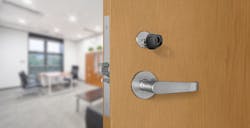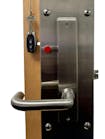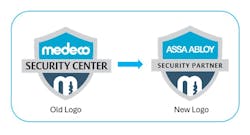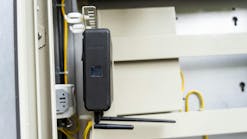When clients come to you seeking the benefit of your experience and asking what high-security key system is right for them, it can be challenging to outline the pros and cons of mechanical, electronic and electromechanical intelligent-key options.
Here are some points you might want to have in your back pocket during your next client consultation.
Differing Systems
We all know the makings of mechanical key systems, but it’s important to note that, to be deemed high security, mechanical cylinders must be UL437 listed and ANSI 156.30 certified. These ratings attest to the unit’s capability to resist physical attacks and surreptitious entry.
Electronic access control (EAC) systems grant access by comparing the credential presented at the door (keypad, smartphone, fingerprint, key fob or key card) to a database of authorized credentials. Many times, these locks incorporate a standard mechanical cylinder as the override.
Straddling both of these are intelligent key systems, a subset of electromechanical solutions. Intelligent key systems include a cylinder that has the attributes of a mechanical cylinder but provides the convenience and flexibility of access control through the use of an intelligent key that has EAC attributes built in.
Be aware that most intelligent cylinders aren’t UL437 certified and, therefore, not suited for high-security applications, because they don’t protect against drilling and other physical attacks. Let’s take a look at pros and cons of each system in a variety of areas.
Security
A single facility often requires different levels of security for different areas. For example, an organization’s human-resources area likely requires a more robust level of security than does its marketing department. Conference rooms that contain expensive audiovisual equipment call for higher security than does a janitorial closet.
Unfortunately, because keys are lost, stolen or duplicated easily, with standard mechanical locking systems, the moment the system administrator distributes keys, the system’s security starts to weaken.
In addition to protecting against picking and drilling, today’s most effective high-security mechanical locking systems also incorporate moving or magnetic components in the key and cylinder that protect against more-advanced attempts to gain entry, including the use of 3D-printed keys. For an added layer of security, the highest security mechanical cylinders are protected by utility patents that make it illegal for unauthorized parties to duplicate keys.
With intelligent and EAC systems, if a security threat arises — for example, if there’s a change in personnel — the intelligent key, electronic fob or key card quickly can be rendered inoperative by using a smart device.
However, electronic access systems can be susceptible to one critical point of failure. A mechanical lock is typically added to an EAC system to provide access to the door during instances when electronics become inoperable. This can occur when there’s a power outage, battery failure, a fire or even a network failure. The mechanical lock is used as a backup and is operated by a mechanical key that retracts the latch to allow access. This operation bypasses the electronic portion of the access control device and provides full, unrestricted access to the user.
Unfortunately, standard mechanical cylinders are easy targets for physical attacks — picking, drilling, pulling, bumping — as well as unauthorized key duplication. Unless keys are patent-protected, individuals can sidestep the system and easily duplicate keys.
In some cases, unauthorized entry can remain undetected for weeks, and even months. In these instances, the customer loses the control and accountability they were depending on. Control is forfeited, because the user no longer can manage who has access, when they have access or to which spaces they have access. Accountability is lost, because an audit trail doesn’t exist.
Therefore, most EAC systems are only as secure as the override key cylinder used in the mechanical lock.
Ease of Installation
Mechanical locks and intelligent cylinders are easy to install, because they don’t require electrical power, hard wiring, cables or changes to existing door hardware. Simply remove the existing cylinder and install the new cylinder, whether mechanical or intelligent.
In contrast, electronic systems require extensive network cabling and conduit, a process that can prove costly and time-consuming.
Accessibility/Convenience
Undoubtedly, mechanical locks have limitations when it comes to accessibility and convenience. If you don’t have the right key to operate a certain lock, you’re out of luck. If you have a key, you have access to that lock 24/7 with no limitations. For many companies, however, 24/7 access might not be seen as a positive. In addition, occupants must carry multiple keys to access different spaces within the building.
In contrast, electronic and intelligent key systems allow users to access multiple locks by using a single key, key card, fob or smart device. Credentials also can be programmed to operate only during certain times of the day or for a limited number of days. For example, administrators can program intelligent keys to become inactive on a specific day or at a specific time — Friday at 6 p.m. when the building closes for the weekend, for example. This will disable the key until Monday morning. The same holds true of electronic locks.
Electronic locks go a bit further with convenience. For example, if a resident is locked out of their apartment, an administrator can send a one-time PIN to the resident’s smart device that they can enter on the keypad to gain access.
Initial Cost
Mechanical locks are significantly less expensive than electronic door locks, particularly if the latter were purchased with a variety of additional bells and whistles.
If one considers that the cost of electronic systems average $3,000-$5,000 per opening, this option quickly can exceed the budget of many organizations.
Intelligent key systems are cost-effective relative to EAC systems in two ways: They’re designed to retrofit with existing door hardware, and there’s no need to install network cabling or to run electricity to each lock.
Lifetime Cost
High-security mechanical key systems can rack up high lifetime costs if they’re managed poorly. For example, if keys continually are lost or unaccounted for, facility managers might be forced to change out locks and replace keys frequently.
Intelligent and electronic systems enable system managers to respond quickly to security threats, lost or stolen keys, or personnel changes without the added cost of changing locks and keys. Changes to access rights can be accomplished in seconds by using any smart device.
Access Tracking
If your clients are interested in monitoring what individuals access doorways and when, they will want to choose an electronic or intelligent key system. Because electronic systems rely on a PIN code, card or fob assigned to one individual, it’s easy to track use.
Keys and cylinders used in intelligent key systems provide access information by recording the date and time of every event (each time a lock is locked or unlocked), including all unauthorized attempts. The most robust systems store up to 10,000 events in the lock and key.
Aesthetics
Mechanical door locks generally offer a wider range of styles and finishes, while electronic door locks have more minimal, sleek designs. However, some electronic systems can be seen as aesthetically intrusive, because they require a separate card-reading device installed alongside or on the door.
Intelligent key systems typically are viewed as minimalist, because the door’s locking cylinder looks like a standard cylinder. In fact, venues that hold design in high esteem, such as museums, opt for these systems, because they’re inconspicuous and do not detract from the visitor’s experience.
Making the Recommendation
The truth is most facilities could use all three types of systems, and the right solution for some applications might go against what’s expected. That’s where your expertise and experience come in.
For example, you might expect a high-security government agency to opt for a sophisticated EAC system. But if that facility already uses extensive video-monitoring systems and has guards posted at multiple access points, project managers might opt for an intelligent key system that protects against physical attacks at the lock cylinder itself.
Meanwhile, municipal utility companies might select intelligent locking systems over strictly mechanical systems, because they can issue electronic keys to grant employees or contractors access to perimeter padlocks to guard against acts of sabotage or vandalism. Such systems allow administrators to audit closely sites to comply with government risk-assessment requirements.
In the end, because budget is usually a predominant factor, the right solution is contingent upon understanding the customer’s issues and addressing their security goals. Locksmiths must weigh the customer’s security demands against the initial and lifetime costs of a high-security system and be sure to educate the customer on the pros and cons of all available options.
Dale L. Bowman, CML, CPP, PSP, PCI, LEED BD+C, is Medeco’s Director of Business Development, OEM and International Sales.
Dale L. Bowman
Dale L. Bowman, CML, CPP, PSP, PCI, LEED BD+C, is Medeco’s director of business development, OEM and international sales.









